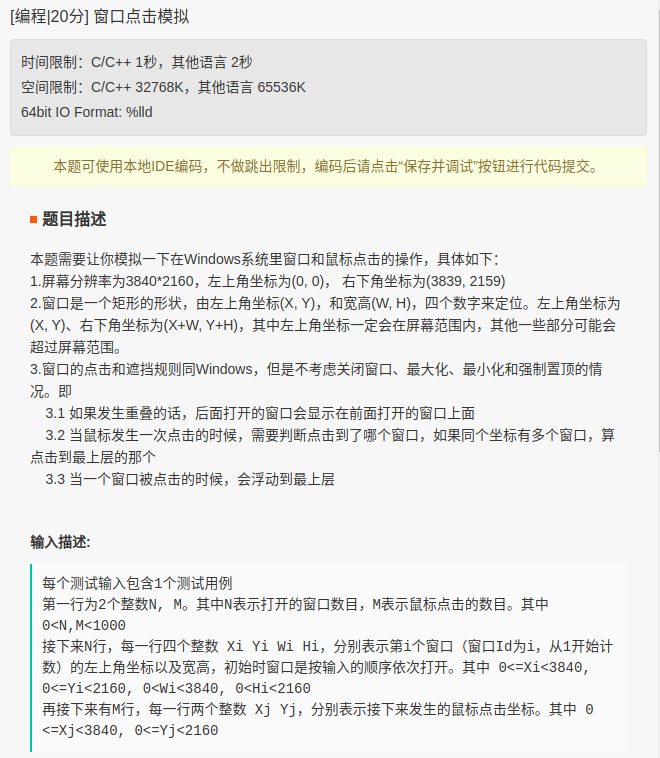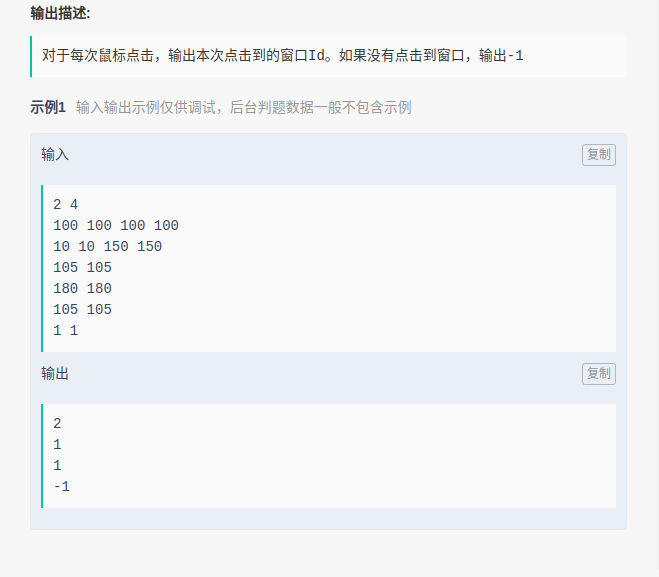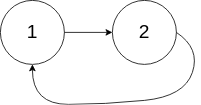原文作者:aircraft
原文链接:https://www.cnblogs.com/DOMLX/p/11209807.html
一套面试题的目录在此,还在继续完善中。。。。。。
c/c++ 2019面试题目录
一.1道网易c++的面试题


我当时第一时间的解答方案
#include <iostream>
#include <vector>
using namespace std;
int main()
{
const int Wi = 3840;
const int Hi = 2160;
int N,M;
int temp;
int x,y,w,h;
int x1,y1;
int b;
vector<vector<int> > Windows(0, vector<int> (4));
vector<int> Window;
vector<vector<int> > pos(0, vector<int> (2));
vector<int> po;
vector<int> nums;
vector<int> SX;
cin >> N >> M;
if(N<=0 || M >= 1000) return 0;
for(int i = 0;i < N;i++){
SX.emplace_back(N-i);
cin>>x>>y>>w>>h;
Window.emplace_back(x);
Window.emplace_back(y);
Window.emplace_back(w);
Window.emplace_back(h);
Windows.emplace_back(Window);
Window.clear();
}
for(int j = 0; j < M; j++){
cin>>x1>>y1;
po.emplace_back(x1);
po.emplace_back(y1);
pos.emplace_back(po);
po.clear();
}
for(int k = 0; k < M; k++){
int flag = -1;
for(int i = 0; i < N; i++){
if(flag = -1)
if(Windows[SX[i] - 1][0] <= pos[k][0] && (Windows[SX[i] -1][0]+Windows[SX[i] -1][2])>=pos[k][0] && Windows[SX[i]-1][1] <= pos[k][1] && (Windows[SX[i]-1][1]+Windows[SX[i]-1][3])>=pos[k][1]){
flag = SX[i];
int size = SX.size();
for(int j = i - 1; j >= 0 ;j--){
SX[j + 1] = SX[j];
}
SX[0] = flag;
break;
}
}
nums.emplace_back(flag);
flag = -1;
}
for(auto num:nums){
cout<<num<<endl;
}
}
二.环形链表
给定一个链表,判断链表中是否有环。
为了表示给定链表中的环,我们使用整数 pos 来表示链表尾连接到链表中的位置(索引从 0 开始)。 如果 pos 是 -1,则在该链表中没有环。
示例 1:
输入:head = [3,2,0,-4], pos = 1
输出:true
解释:链表中有一个环,其尾部连接到第二个节点。

示例 2:
输入:head = [1,2], pos = 0
输出:true
解释:链表中有一个环,其尾部连接到第一个节点。

示例 3:
输入:head = [1], pos = -1
输出:false
解释:链表中没有环。

进阶:
你能用 O(1)(即,常量)内存解决此问题吗?
我的代码:20ms
/**
* Definition for singly-linked list.
* struct ListNode {
* int val;
* ListNode *next;
* ListNode(int x) : val(x), next(NULL) {}
* };
*/
class Solution {
public:
bool hasCycle(ListNode *head) {
if(head == NULL) return false;
unordered_map<ListNode*,int> umap;
ListNode *node = head;
while(node->next != NULL){
umap[node]++;
if(umap[node] > 1) return true;
node = node->next;
}
return false;
}
};
我的思路就是把每个链表遍历存储在map容器中,出现已经存放的地址时申请再次存放时,这时候就是环形链表。
大佬们的代码5ms左右:
class Solution {
public:
bool hasCycle(ListNode *head) {
if(head == NULL)
return false;
ListNode *slow,*fast;
slow = head;
fast = head;
while(slow && fast)
{
slow = slow->next;
fast = fast->next;
if(fast)
fast = fast->next;
else
return false;
if(slow == fast)
return true;
}
return false;
}
};
这个代码思路就是快慢指针,如果链表出现环形,那么我的快慢指针一定会相遇。
3.二叉树的最大深度:
给定一个二叉树,找出其最大深度。
二叉树的深度为根节点到最远叶子节点的最长路径上的节点数。
说明: 叶子节点是指没有子节点的节点。
示例:
给定二叉树 [3,9,20,null,null,15,7],
3
/
9 20
/
15 7
返回它的最大深度 3
我的代码:16ms
/**
* Definition for a binary tree node.
* struct TreeNode {
* int val;
* TreeNode *left;
* TreeNode *right;
* TreeNode(int x) : val(x), left(NULL), right(NULL) {}
* };
*/
class Solution {
public:
int count = 0;
int max = 0;
int maxDepth(TreeNode* root) {
if(root == NULL) return 0;
count++;
if(count > max) max = count;
maxDepth(root->left);
maxDepth(root->right);
count--;
return max;
}
};
我的思路就是全部遍历一遍,记录最大深度。
大佬的代码:4ms
/**
* Definition for a binary tree node.
* struct TreeNode {
* int val;
* TreeNode *left;
* TreeNode *right;
* TreeNode(int x) : val(x), left(NULL), right(NULL) {}
* };
*/
class Solution {
public:
int detectDepth(TreeNode* node) {
if (!node) return 0;
int leftDepth = 1 + detectDepth(node -> left);
int rightDepth = 1 + detectDepth(node -> right);
return std::max(leftDepth, rightDepth);
}
int maxDepth(TreeNode* root) {
return detectDepth(root);
}
};
这个代码就是跟我的思路差不多,不过用递归的方法优化,比我好多了。
4.验证二叉搜索树
给定一个二叉树,判断其是否是一个有效的二叉搜索树。
假设一个二叉搜索树具有如下特征:
- 节点的左子树只包含小于当前节点的数。
- 节点的右子树只包含大于当前节点的数。
- 所有左子树和右子树自身必须也是二叉搜索树。
示例 1:
输入:
2
/
1 3
输出: true
示例 2:
输入: 5 / 1 4 / 3 6 输出: false 解释: 输入为: [5,1,4,null,null,3,6]。 根节点的值为 5 ,但是其右子节点值为 4 。
我的代码24ms
/**
* Definition for a binary tree node.
* struct TreeNode {
* int val;
* TreeNode *left;
* TreeNode *right;
* TreeNode(int x) : val(x), left(NULL), right(NULL) {}
* };
*/
class Solution {
public:
bool flag = 1;
int ergodic(TreeNode* root,long min,long max){
if(root == NULL) return 0;
if(root->left != NULL){
if(root->left->val >= root->val || root->left->val <= min){
flag = 0;
return 0;
}
ergodic(root->left,min,root->val);
}
if(root->right != NULL){
if(root->right->val <= root->val || root->right->val >= max){
flag = 0;
return 0;
}
ergodic(root->right,root->val,max);
}
return 0;
}
bool isValidBST(TreeNode* root) {
if(root == NULL) return 1;
if(root->left != NULL){
if(root->left->val >= root->val){
flag = 0;
return 0;
}
ergodic(root->left,LONG_MIN,root->val);
}
if(root->right != NULL){
if(root->right->val <= root->val){
flag = 0;
return 0;
}
ergodic(root->right,root->val,LONG_MAX);
}
return flag;
}
};
我的方法就是递归遍历加上数值判断
大佬的代码:8ms
/**
* Definition for a binary tree node.
* struct TreeNode {
* int val;
* TreeNode *left;
* TreeNode *right;
* TreeNode(int x) : val(x), left(NULL), right(NULL) {}
* };
*/
class Solution {
public:
bool isValidBST(TreeNode* root, long long min = LONG_LONG_MIN, long long max = LONG_LONG_MAX) {
if(root == NULL) return true;
if(root->val <= min || root->val >= max) return false;
return isValidBST(root->left, min, root->val) && isValidBST(root->right, root->val, max);
}
};
这个代码其实思路是跟我差不多的,但是代码的简洁和调用库函数来判断,比我那乱七八糟的好太多了。
5.对称二叉树
给定一个二叉树,检查它是否是镜像对称的。
例如,二叉树 [1,2,2,3,4,4,3] 是对称的。
1
/
2 2
/ /
3 4 4 3
但是下面这个 [1,2,2,null,3,null,3] 则不是镜像对称的:
1
/
2 2
3 3
说明:
如果你可以运用递归和迭代两种方法解决这个问题,会很加分。
我的代码:8ms
/**
* Definition for a binary tree node.
* struct TreeNode {
* int val;
* TreeNode *left;
* TreeNode *right;
* TreeNode(int x) : val(x), left(NULL), right(NULL) {}
* };
*/
class Solution {
public:
int flag = 1;
int left = 0;
int right = 0;
vector<int> leftTree,rightTree;
void leftRecursiveComparison(TreeNode* root){
if(root){
left++;
leftRecursiveComparison(root->left);
leftTree.emplace_back(root->val);
leftRecursiveComparison(root->right);
}
else leftTree.emplace_back(left);
}
void rightRecursiveComparison(TreeNode* root){
if(root){
right++;
rightRecursiveComparison(root->right);
rightTree.emplace_back(root->val);
rightRecursiveComparison(root->left);
}
else rightTree.emplace_back(right);
}
bool isSymmetric(TreeNode* root) {
if(root == NULL) return true;
leftRecursiveComparison(root->left);
rightRecursiveComparison(root->right);
int lenLeft = leftTree.size();
int lenRight = rightTree.size();
if(lenLeft != lenRight) return false;
for(int i = 0; i < lenLeft; i++){
cout<<rightTree[i];
if(leftTree[i] != rightTree[i])
return false;
}
return true;
}
};
我的思路已经不想讲了 ,直接看大佬的吧。
大佬们的代码:1ms左右
class Solution {
public:
bool isSymmetric(TreeNode* root) {
if(root==nullptr) return true;
return helper(root->left,root->right);
}
bool helper(TreeNode* left,TreeNode* right){
if(left==nullptr&&right==nullptr) return true;
if(left==nullptr||right==nullptr) return false;
return (left->val==right->val)&&helper(left->left,right->right)
&&helper(left->right,right->left);
}
};
大佬这个就是同时对两边的子树进行递归遍历,然后需要对称的值进行判断。
哎,看看自己跟大佬们的代码就知道差距了QAQ................
若有兴趣交流分享技术,可关注本人公众号,里面会不定期的分享各种编程教程,和共享源码,诸如研究分享关于c/c++,python,前端,后端,opencv,halcon,opengl,机器学习深度学习之类有关于基础编程,图像处理和机器视觉开发的知识
